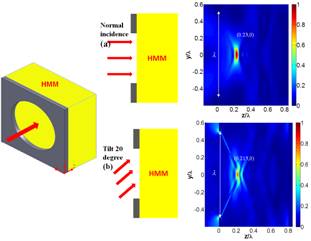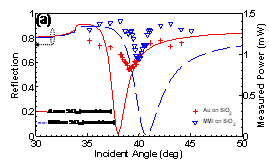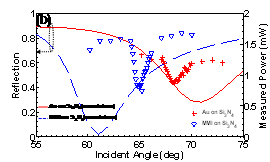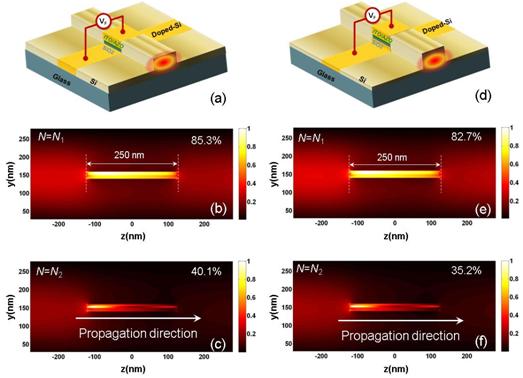57th Annual Report on Research 2012 Under Sponsorship of the ACS Petroleum Research Fund
Reports: DNI1050277-DNI10: Plasmon-Enhanced Light-Trapping for Thin-Film Solar Cells
Zhaolin Lu, PhD, Rochester Institute of Technology
Microsystems Engineering, Rochester Institute of Technology, Rochester, NY 14623
This program is focused on increasing light harvesting in thin film solar cells by exploiting the light trapping effects of surface plasmons and photonic crystals. This research in last year has resulted in 5 journal papers (one invited review paper), and 5 conference papers/presentations. A workshop was given in 2012 Energy Materials Nanotechnology Meeting. Most of the research results have been or will be published in journal or conference papers. Accordingly, this report only contains milestone data of research since September, 2011.
1. Deep Subwavelength Power Concentration by Indefinite Metamaterials
Figure1. Numerical simulation results for power concentration using HMM (a) at normal incidence (b) with tilt angle of 20º. |
In this project, we showed that a multilayer metal-insulator stack with a suitable filling ratio can function as an anisotropic metamaterial with positive dielectric constant in one direction and negative in another. This "indefinite metamaterial" provides significant advantages over conventional materials in some applications. We experimentally demonstrated super power concentration using an indefinite metamaterial based on a wired medium. This super-focusing ability down to λ/6 was verified both numerically and experimentally. This phenomenon can be further explored for applications in nanolithography, optical tweezers, solar cells, nano-waveguide coupler and optical storage. See Fig. 1.
2. Multilayer Metal-Insulator Stacks for Light Trapping
Figure 2. Numerical and experimental results of reflection vs incident angle for (a) increased ESPF and (b) decreased ESPF. |
In this project, we investigated a multilayered metal-insulator (MMI) stack system, and demonstrated the tuning of effective surface plasmon frequency (ESPF). Based on the classical Kretschmann setup, the MMI system is experimentally tested as an anisotropic material to exhibit plasmonic behavior and a candidate of "metametal" to engineer the preset surface plasmon frequency of conventional metals for light trapping applications. As shown in Fig. 2, the ESPF and absorption peak can be either tuned down or up. The design rules drawn in this project would bring important insights into applications such as solar cells, optical lithography, nano-sensing and imaging.
3. Graphene-Enhanced Light Absorption
We studied the optical conductivity and dielectric constant of graphene under different chemical potentials. Due to the effect of intraband absorption, the magnitude of graphene dielectric constant can be dynamically tuned in a large range by electrical gating. In particular, with a suitable gate voltage, the dielectric constant of graphene can be tuned to be very small, resulting in "graphene-slot waveguides" and greatly enhanced absorption modes. See Fig. 3.
Figure 3. The calculation of graphene conductivity and dielectric constant as a function of chemical potential and wavelength, and application in a sandwiched structure.
4. Electro-Absorption Modulators Based on Transparent Conducting Oxides
In this project, we explore the enhanced light absorption by epsilon-near-zero (ENZ) materials. When a thin ENZ film is sandwiched in a single mode waveguide, an ENZ-slot waveguide is formed, where the absorption can be greatly enhanced. We propose electro-absorption modulators based on tunable ENZ materials and slot waveguides. Transparent conducting oxides (TCOs) may be employed as the active slot which can be tuned between epsilon-near-zero (high absorption) and epsilon-far-from-zero (low absorption) by accumulation carriers. Numerical simulation shows that over 3-dB modulation depth can be achieved in a 250-nm long TCO-slot waveguide. See Fig. 4. Successful development of this technique will be one milestone toward the removal of the thermal bottleneck faced in semiconductor industry.
Figure 4. The illustration and 3D simulation of light propagation between a rib Si waveguide and the EA modulator.
5. Impact on PI's Career
The PI is an expert in nanophotonics and plasmonics, while solar cells are quite a new topic for the PI. This program gives the PI an opportunity to meet with one of the most critical issues facing human being. The outcome of this effort is to design and verify a prototype for further research.
6. Impact on the Students
In addition to the PI, this project supported the five graduate students. The research results have been incorporated in two courses: Optoelectronics and Integrated Optics. Two invited lectures were given in the Introduction of Microsystems and Nanotechology based on the results of this program.
7. Plans for Next Year
We will keep on studying the enhanced light-trapping based on surface plasmons. In addition, we will extend the exploration into the recently discovered graphene-based solar cells. In this case, graphene is treated as a new energy-harvesting material, whose absorption spectrum can be controlled by applied electric gating.
8. List of Publications for this Program:
(1) A. Kaur, S. Banerjee, W. Zhao, J. Venkataraman, and Z. Lu, "Deep Subwavelength Power Concentration Based Hyperbolic Metamaterials," International journal of optics (Accepted).
(2) R. Yang, X. Huang, and Z. Lu, "Arbitrary super surface modes bounded by multilayered metametal," Micromachines vol. 3, Special Issue on "Nano-photonic Devices", 45-54 (2012).
(3) Z. Lu and W. Zhao, "Nanoscale electro-optic modulators based on graphene-slot waveguides," J. Opt. Soc. Am. B vol. 29, 1490-1496 (2012).
(4) Z. Lu, W. Zhao, and K. Shi, "Ultracompact electro-absorption modulators based on tunable epsilon-near-zero-slot waveguides," IEEE Photonics Journal, vol. 4, 735-740(2012).
(5) R. Yang and Z. Lu, "Subwavelength Plasmonic Waveguides and Plasmonic Materials," International Journal of Optics, vol. 2012, 258013 (12) (2012).
(6) Z. Lu, "Nanoplasmonic Devices Based on Graphene and Slot Waveguides," 2012 Energy Materials Nanotechnology Meeting, Orlando, Florida, April 2012 (Invited Talk/Workshop).
(7) A. Kaur, S. Banerjee, W. Zhao, and Z. Lu, "Deep Subwavelength Focusing of Broad Beam Using Hyperbolic Metamaterial," Frontiers in Optics/Laser Science (FiO/LS), 2012 (accepted).
(8) W. Zhao and Z. Lu, "Transparent Conducting Oxides Based Nanoscale Electro-Optic Modulators," Frontiers in Optics/Laser Science XXVIII (FiO/LS), 2012 (accepted).
(9) W. Zhao and Z. Lu, "Applications of Transparent Conducting Oxides in Plasmonic/Optical Modulators," ICPEPA-8, 2012.
(10)R. Yang and Z. Lu, "Dispersion engineering for surface waves on multilayer metal-insulator stacks," Proceedings of SPIE Vol. 8269, 82692D (2012).















